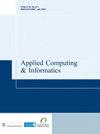应用迁移学习进行糖尿病视网膜病变分期
IF 4.9
Q1 COMPUTER SCIENCE, INFORMATION SYSTEMS
引用次数: 4
摘要
目的糖尿病视网膜病变(DR)是糖尿病的危险并发症之一。必须跟踪其等级水平,以管理其进展,并及时做出适当的治疗决定。为了减轻眼科医生的负担和手册读者之间的诊断矛盾,有必要采用有效的自动化方法来检测DR及其严重程度阶段的分类。设计/方法/方法在本研究中,卷积神经网络(CNN)基于彩色视网膜眼底图像用于DR的检测和分期分类。CNN可以识别视网膜上复杂的特征,并提供自动诊断。使用迁移学习(TL)方法应用预先训练的VGG-16 CNN模型,以在检测中利用已经学习的参数。发现通过进行不同严重程度分组的不同实验,所取得的结果是有希望的。2类、3类、4类和5类分类的最佳精度分别为86.5、80.5、63.5和73.7。独创性/价值在本研究中,VGG-16用于使用TL方法检测和分类DR分期。在DR严重程度阶段的分类中使用了不同的类别组合,以说明模型区分类别的能力,并验证这些变化对模型性能的影响。本文章由计算机程序翻译,如有差异,请以英文原文为准。
Using transfer learning for diabetic retinopathy stage classification
PurposeDiabetic retinopathy (DR) is one of the dangerous complications of diabetes. Its grade level must be tracked to manage its progress and to start the appropriate decision for treatment in time. Effective automated methods for the detection of DR and the classification of its severity stage are necessary to reduce the burden on ophthalmologists and diagnostic contradictions among manual readers.Design/methodology/approachIn this research, convolutional neural network (CNN) was used based on colored retinal fundus images for the detection of DR and classification of its stages. CNN can recognize sophisticated features on the retina and provides an automatic diagnosis. The pre-trained VGG-16 CNN model was applied using a transfer learning (TL) approach to utilize the already learned parameters in the detection.FindingsBy conducting different experiments set up with different severity groupings, the achieved results are promising. The best-achieved accuracies for 2-class, 3-class, 4-class and 5-class classifications are 86.5, 80.5, 63.5 and 73.7, respectively.Originality/valueIn this research, VGG-16 was used to detect and classify DR stages using the TL approach. Different combinations of classes were used in the classification of DR severity stages to illustrate the ability of the model to differentiate between the classes and verify the effect of these changes on the performance of the model.
求助全文
通过发布文献求助,成功后即可免费获取论文全文。
去求助
来源期刊

Applied Computing and Informatics
Computer Science-Information Systems
CiteScore
12.20
自引率
0.00%
发文量
0
审稿时长
39 weeks
期刊介绍:
Applied Computing and Informatics aims to be timely in disseminating leading-edge knowledge to researchers, practitioners and academics whose interest is in the latest developments in applied computing and information systems concepts, strategies, practices, tools and technologies. In particular, the journal encourages research studies that have significant contributions to make to the continuous development and improvement of IT practices in the Kingdom of Saudi Arabia and other countries. By doing so, the journal attempts to bridge the gap between the academic and industrial community, and therefore, welcomes theoretically grounded, methodologically sound research studies that address various IT-related problems and innovations of an applied nature. The journal will serve as a forum for practitioners, researchers, managers and IT policy makers to share their knowledge and experience in the design, development, implementation, management and evaluation of various IT applications. Contributions may deal with, but are not limited to: • Internet and E-Commerce Architecture, Infrastructure, Models, Deployment Strategies and Methodologies. • E-Business and E-Government Adoption. • Mobile Commerce and their Applications. • Applied Telecommunication Networks. • Software Engineering Approaches, Methodologies, Techniques, and Tools. • Applied Data Mining and Warehousing. • Information Strategic Planning and Recourse Management. • Applied Wireless Computing. • Enterprise Resource Planning Systems. • IT Education. • Societal, Cultural, and Ethical Issues of IT. • Policy, Legal and Global Issues of IT. • Enterprise Database Technology.
 求助内容:
求助内容: 应助结果提醒方式:
应助结果提醒方式:


